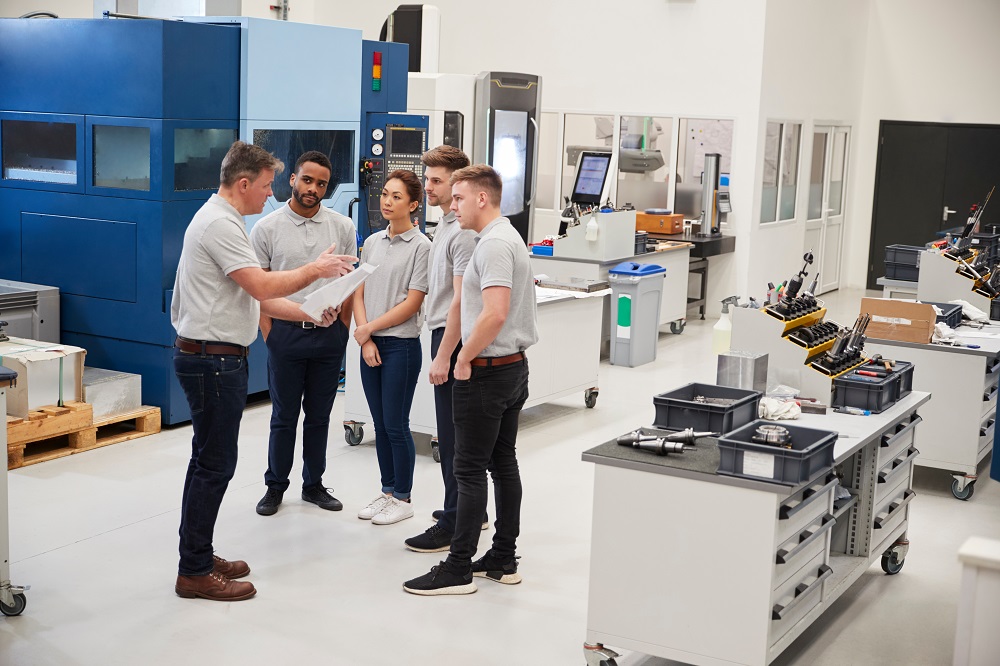The key to success in modern manufacturing is flexibility. Gone are the days of abundant workforces and manual assembly lines. The new generation of manufacturing must be flexible, understand the entire process, and use advanced tools to increase efficiency.
This is what makes cross-functional training so vital to your success. Training cross-functional teams in manufacturing provides significant benefits and improves your competitive edge. Read on to better understand why your organization should consider cross-functional training and how it may impact your workflow.
What is a cross-functional team in manufacturing?
In manufacturing, the most common form of cross-functional training is found on the production floor. A cross-functional team in manufacturing is trained to use different types of machines, or machine controllers, to maximize efficiency.
By increasing your employees’ flexibility, you gain a team that can operate more fluidly. Through overlapping skill sets, you’ll reduce bottlenecks and ensure your team operates more effectively across your production process.
Are there any negatives to cross-functional training?
Although cross-functional teams are extremely beneficial to a manufacturing operation, the dedicated training employees require to perform their best does take time away from production. Employees also need an instructor to educate them.
While this may seem like a hassle, the long-term value these cross-trained employees will provide your operation is worth the investment. However, if your team is running tight on time, you may want to weigh your options to see if training can wait.
Top Opportunities for Cross-Functional Training
While there are many ways to create cross-functional teams in manufacturing, what you train your team in will vary depending on your needs. Here are some common, high-value opportunities for cross-functional training in manufacturing.
Using Cellular Layouts
Training employees in the use of cellular layouts will reduce the need for departmental specialties and increase efficiency. Switching your layout to a cellular process creates less waste and a more natural production flow.
Training in Quality Control
Training operators alongside your quality control team can potentially reduce your scrap rate. If operators understand quality control, they can keep watch for issues earlier in the process and avoid restarting the process at the end of production.
Setup and Programming
If an operator understands a machine’s setup and programming, they are more valuable across the entire process. From engineering to manufacturing, employees will be able to provide assistance throughout every stage.
Key Benefits of Cross-Functional Teams in Manufacturing
Cross-functional teams present a number of opportunities for your manufacturing operation, each with its own benefit. However, in this modern age of manufacturing, a few key benefits stand out from the rest.
Employee empowerment
By diversifying their skills, your employees will feel empowered in their everyday workflows. Cross-functional training eliminates the need to rely on others to perform a wide range of tasks. This means your employees feel more independent and gain valuable experience in their careers.
Cross-functional training also displays an investment in your workforce’s wellbeing. Investing in employees shows them you support their career, which helps build loyalty.
Increased employee flexibility
With the labor shortage caused by COVID-19, the manufacturing industry faces the challenge of maintaining operations with less available workforce.
Through cross-functional training, your employees’ value increases alongside their flexibility. Employees who can operate several machines, or throughout several phases of production, create instant value for your business. More flexibility means less need for additional labor, which means fewer costs and roadblocks in the long term.
Opportunities for automation
If you’re looking to take your manufacturing operation to the next level, training your employees in automation and robotics is an effective way to increase productivity while reducing labor costs.
Adding an additional layer of automation knowledge to your workforce’s tool belt allows your operation to take advantage of tactics like lights-out and smart manufacturing. These strategies boost your production capabilities by decreasing production times and eliminating unnecessary oversight.
Leverage the potential skill of your employees to boost productivity
Not only does investing in your employees increase their value to you, but it also offers them opportunities to grow and develop professionally. Through cross-functional training, your team can increase productivity, reduce labor costs, and create a more efficient workflow that will save your business time and money.

